The Corsair Hydro X Custom Water Cooling Review, on a Ryzen 9 3950X
by Gavin Bonshor on February 5, 2020 9:00 AM EST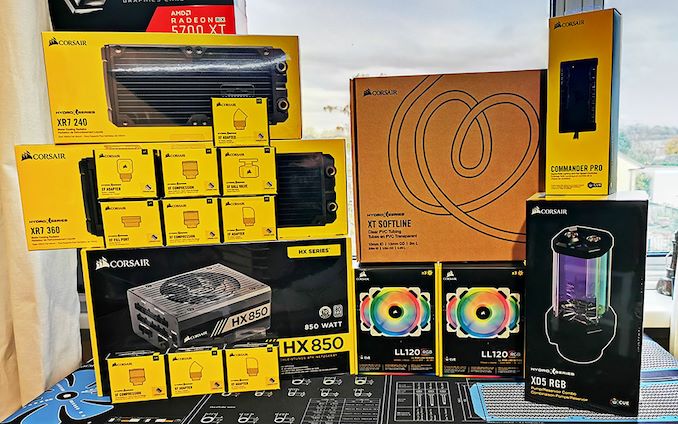
During Computex 2019, Corsair unveiled its new Hydro X series - a new range of water cooling hardware that markts its first entry into custom water cooling market. The range offers CPU blocks for multiple sockets, multiple fittings, tubing types, and a pump/reservoir combo, allowing users can build a high-performance system with nearly all Corsair branded parts. We used the Corsair Hydro X series in our ASRock X570 Aqua review and built a full system to showcase what Corsair is offering, and here is a build log of that system.
The Corsair Hydro X Series: Making a Big Splash
Widely known as one of the major players in the closed-loop cooler markets, Corsair made a big splash into the custom water cooling market with its Hydro X series last year. By offering a family of custom liquid parts that includes CPU blocks, GPU blocks, radiators, a pump and reservoir combination, to a range of coolant and fittings for users to select from to customize a full loop, Corsair is aiming to both undercut the competition but also be able to provide as much of the system as a Corsair as possible.
The Corsair Hydro X series is fully integrated to work with Corsair's iCUE RGB customization software which allows users to run Corsair RGB fans, the Hydro X series, as well as link up devices such as Corsair peripherals. Most companies that use RGB as one of its driving features are focused on creating an immersive ecosystem so that its RGB laden product families can be managed through a single interface. The Corsair Hydro X range, unlike other water cooling brands, is primarily constructed of nylon which as a material, which Corsair claims is more durable and easier to produce in higher quantities.
All of Corsair's Hydro X Series water blocks come with G1/4" threads, and each block has thermal materials pre-applied for ease of use.

Corsair Hydro X Series XC7 CPU Block for LGA115x and AM4
On CPU blocks, Corsair has two series of CPU blocks: the Hydro X Series XC7, and the Hydro X Series XC9. The Corsair Hydro X Series XC7 comes in three varieties, one for Intel's HEDT LGA2066 socket, one for AMD's HEDT sTR4 socket, and a final one designed for both Intel socket LGA115x and AMD AM4 sockets.
The Hydro X Series XC7 includes RGB LED lighting and has 60+ cold plate fins. The XC7 uses nickel-plated copper so compatibility is limited to other water cooling products that use copper and brass internally. The XC7 is available at present in black, while the XC9 comes in silver.

Corsair Hydro X Series XC9 CPU Block for LGA2011/2066 and sTR4/sTRX4
The second of two available processor blocks is the Corsair Hydro X Series XC9 CPU block. This is higher-end in terms of specifications, and is designed solely for the Intel LGA2066 and AMD sTR4 platforms. With a larger than average nickel-plated copper cooling plate designed for larger and more powerful processors, the XC9 has more cooling fins. Like the XC7, the XC9 has a transparent flow chamber for users to see water flow, but the XC9 also has a sandblasted aluminium trim designed to have a more premium look and feel. Again, RGB LEDs are present.
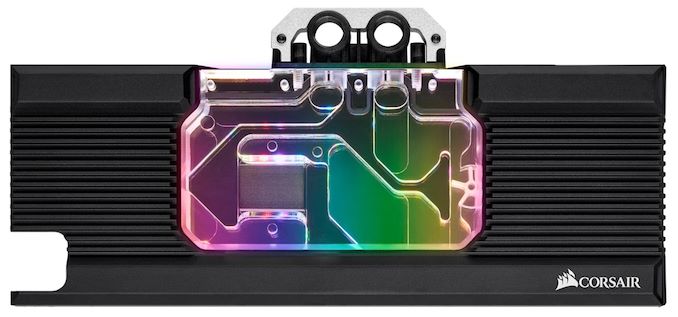
Corsair Hydro X Series XG7 RGB 2080 Ti Founders Edition GPU Block
The XG7 series represents its custom solution graphics card water blocks and although it doesn't support every available model, there is an XG7 model for reference NVIDIA GeForce RTX 2070, 2080, and 2080 Tis. Corsair also has custom variants for the ASUS ROG RTX 2080 and 2080 Ti STRIX models. For the AMD side, only one block is available and has support for reference AMD RX 5700 XT. Each block is constructed from nickel-plated copper, with a full aluminium backplate and comes with 16 integrated individually addressable RGB LEDs. For added style, the block itself has a transparent front cover to allow users to see the flow, and show off colored coolant.
At present, Corsair is offering a single pump and reservoir solution through the Hydro X Series XD5. This includes a Xylem D5 PWM pump with a 330 ml capacity reservoir. Like the majority of the range, the fluid chamber is constructed from Nylon. The the flow rate is advertised as 800 L/h at 2.1 meters of pressure. The Xylem D5 PWM pump is rated up to a maximum of 4800 RPM, and has a power draw of around 30 W. Integrated into the reservoir are ten RGB LEDs which can be controlled by the Corsair iCUE RGB software, and hook up to directly to Corsair's iCUE lighting controller.
Included with the pump are mounting brackets to allow users to mount it in various parts of a system including in drive bays and on 120/140 mm cooling fans. Also supplied is an in-loop temperature probe and a 24-pin power supply jumper so users can fill up without having to power the system components on. This is important for debugging any issues with a loop.
The Corsair Hydro X Series offers two main types of core fittings and tubing. This includes Softline in 10/13 mm ID/OD, and hardline in 14/10 mm. The Hardline is constructed from PMMA, while the Softline is made from PVC. There is a wide variety of fittings to allow users to create the right configuration including 45° and 90° angled fittings, as well as rotary splitters, ball valves, and a fill port.
The fittings themselves are constructed from brass and are G1/4" thread. Each core fitting is knurled brass and is available in both silver and black varieties. Corsair states that its range should only be used with other parts constructed from copper and brass to avoid mixing metals which can cause corrosion.
It wouldn't be a full water cooling series without radiators, and Corsair is offering its slim 30 mm XR5 radiators in six sizes including 120, 140, 240, 280, 360, and 420 mm. The thicker XR7 radiators are available in 240 mm, 360 mm and in a larger 480 mm size. Each XR7 radiator is 54 mm thick and is constructed from copper and brass, with support for 120 mm cooling fans. Dependant on the size and space inside the chassis, each radiator supports both push and pull for better cooling performance. At present, the radiators are only available in black.
The Corsair Hydro X Series XL5 coolant is manufactured by renowned fluid specialist Mayhems Solutions and is available in clear, and four colors. This includes red, green, blue and purple and each bottle is available in 1 liter capacities.


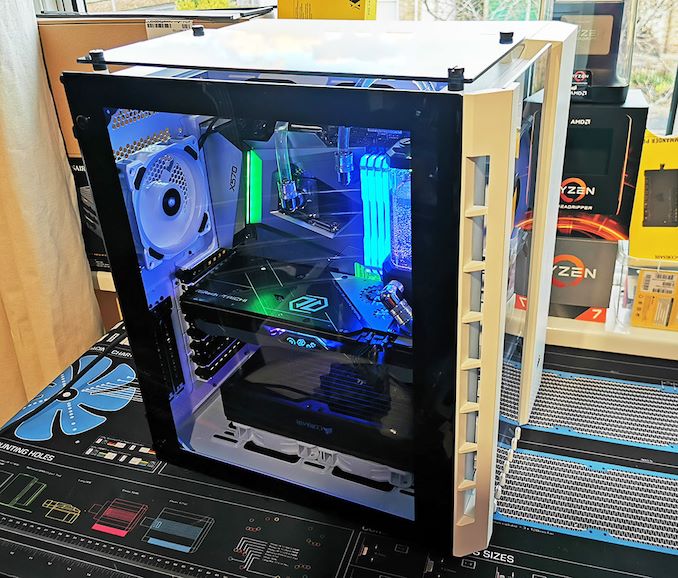
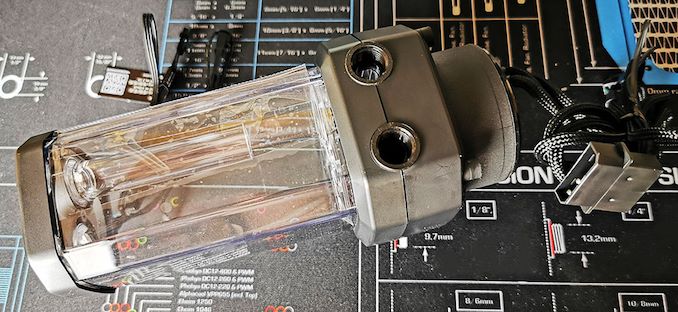
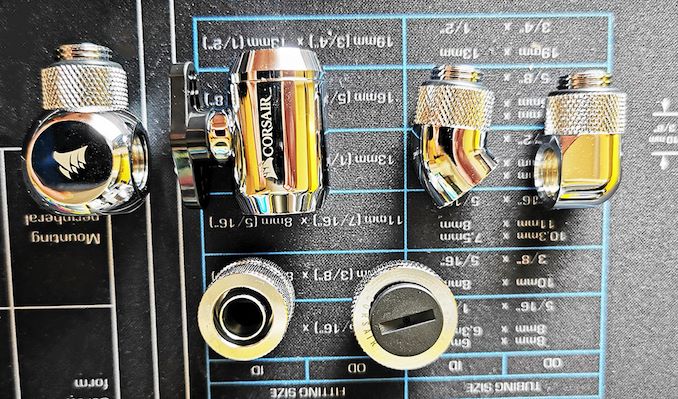
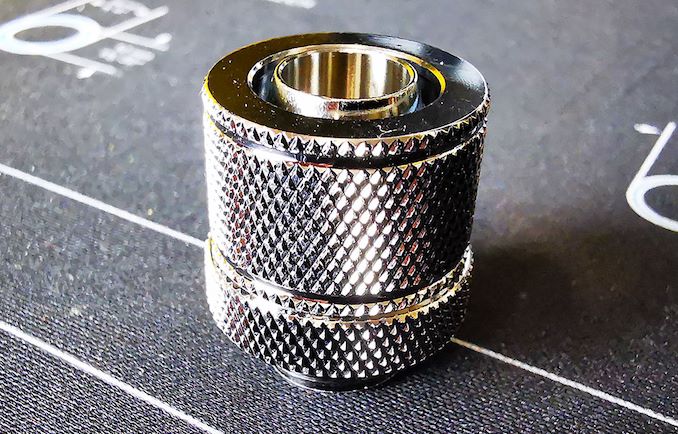
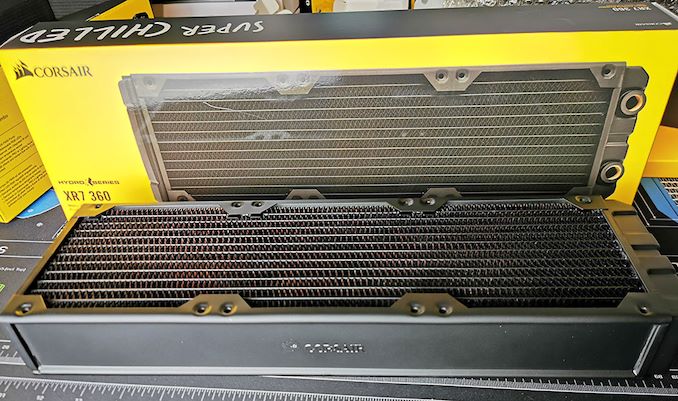









72 Comments
View All Comments
LedHed - Wednesday, February 5, 2020 - link
If you read the review, he had to use the 240mm because of space constraints (caused by the E-ATX motherboard).I wish he would have ran this guy without the ASRock power delivery H2O block/s connected.
I.E. Just shown us the performance of cooling the CPU alone, since no AIO cooler can connect to multiple blocks and the review is meant to be against AIO coolers.
Samus - Wednesday, February 5, 2020 - link
You can easily get away with a 120x38 radiator on a 84w CPU, but you will need a push and pull fan to effectively cool that radiator. I’ve run 54-65w CPU’s with full core boost enabled on cheap closed loop coolers with those thin 25mm radiators and “they work” but you need two fans and they will run at full speed during load. Don’t ask me why, it’s what the customer wanted :Pbrontes - Wednesday, February 5, 2020 - link
My bad. It's mentioned that Corsairs only amd gpu block is for 5700 XT, the test bed uses 5700 XT, but upon closer inspection of course they're using stock air cooler.Why would you ever custom loop for just the cpu.
FatBoyDiesel - Wednesday, February 5, 2020 - link
I've got a Radeon VII with an EKWB GPU block, Coolstream SE 240mm radiator, 2 EK-Furious Vardar fans, and a DDC pump. I also have a Corsair Hydro XC7 CPU block for my 3900X, all soft tubing. I'm especially curious to see the noise comparison between this setup versus air cooled Radeon VII and an H100i v2 Platinum 240mm AIO. Mind you, that AIO got pretty loud.LedHed - Wednesday, February 5, 2020 - link
As well as the common AIO coolers, like the x62, H110 and H115.Who the heck owns an ID-Cooling Auraflow 240??
anactoraaron - Wednesday, February 5, 2020 - link
Yeah this whole article seems like a corsair ad. It's almost like corsair found a very poor performing aio and sent it with everything else.AshlayW - Thursday, February 6, 2020 - link
Oh shut up. Arm-chair reviewer sat behind their monitor complaining about everything. Perhaps the author only had that model on hand at the time. They still put a lot of effort into reviewing it and you can take the Delta figures and compare to another more comprehensive AIO review elsewhere.Don't comment if you're going to post such dumb complaints.
anactoraaron - Thursday, February 6, 2020 - link
I would expect a reasonable comparison of similar coolers, popular air and aio, in a credible tech website like Anandtech. If most small time youtubers can do this it shouldn't be that difficult. What tech reviewer doesn't have an x62, h115 or h100, and a NH-D15 already? It would be like only having an AMD g3000 as the only amd chip for comparison to an intel 9900k.Looking at numbers from 'elsewhere' will have a different test bench, different ambient temps, and in general will not be similar in any way to this review.
Sit down troll. Go find an intelligent comment and try again.
PeachNCream - Thursday, February 6, 2020 - link
Let's not omit the fact that Corsair did hire someone from Anandtech so there is a connection. However, I do not believe that AT overtly advertises without making it abundantly clear content is paid for by a third party. Ryan and company may let a few typos slip here and there and yes, debating article quality is fair (including pointing out personal bias *cough* Killer NICs *cough*), but I don't think there is any reason at all to question their journalistic integrity.Drkrieger01 - Wednesday, February 5, 2020 - link
I recently put an EKWB block on my EVGA 2080 Ti. In the loop, I used a Corsair XR5 240mm radiator, and I have to say, I was very pleasantly impressed by the quality of the rad for its price. The screw/tube protectors are by far the best feature I've seen on a low cost radiator in a very long time. The cooling performance was also astronomical (can't break 52 C under max load on GPU w/overclock)